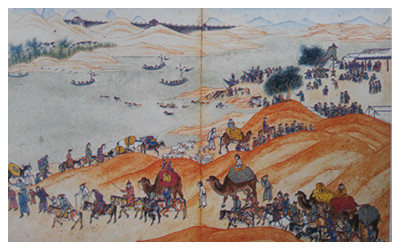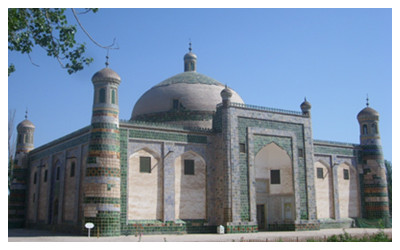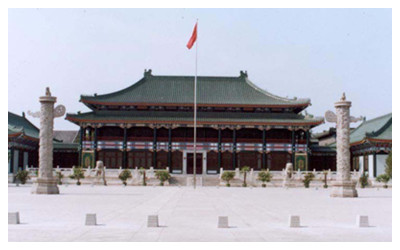Skype: neodalle-travel
Tel: +86 135 7447 2266
E-mail: sales@visitaroundchina.com
 Xinjiang was called simply "Western Region" which has been part of China since ancient times. The Jiaohe ruins, Gaochang ruins, Yangqi Mansion of "A Thousand Houses," Baicheng (Bay) Kizil Thousand Buddha Grottoes, Bozklik Grottoes in Turpan, Kumtula Grottoes in Kuqa and Astana Tombs in Turpan all contain a great wealth of relics from the Western and Eastern Han dynasties (206 B.C. -- A.D.220). They bear witness to the efforts of the Uygurs and other ethnic groups in Xinjiang in developing China and its culture.
Xinjiang was called simply "Western Region" which has been part of China since ancient times. The Jiaohe ruins, Gaochang ruins, Yangqi Mansion of "A Thousand Houses," Baicheng (Bay) Kizil Thousand Buddha Grottoes, Bozklik Grottoes in Turpan, Kumtula Grottoes in Kuqa and Astana Tombs in Turpan all contain a great wealth of relics from the Western and Eastern Han dynasties (206 B.C. -- A.D.220). They bear witness to the efforts of the Uygurs and other ethnic groups in Xinjiang in developing China and its culture.Zhang Qian, who lived in the second century B.C., went to the Western Region as an official envoy in 138 and 119 B.C., further strengthening ties between China and central Asia via the "Silk Road." In 60 B.C., Emperor Xuan Di of the Western Han Dynasty established the Office of Governor of the Western Region to supervise the "36 states" north and south of the Tianshan Mountains with the westernmost border running through areas east and south of Lake Balkhash and the Pamirs.
During the Wei, Jin, Northern and Southern dynasties (220-581 A.D.) the Western Reigon was a political dependent of the government in central China. The Wei, Western Jin, Earlier Liang (317-376), Earlier Qin (352-394) and Later Liang (386-403) dynasties all stationed troops and set up administrative bodies there. In 327, Zhang Jun of the Earlier Liang Dynasty set up in Turpan the Gao Chang Prefecture, the first of its kind in the region.
 In the mid-seventh century, the Tang Dynasty established the Anxi Governor's Office in Xizhou (present-day Turpan, it later moved to Guizi, present-day Kuqa) to rule areas south and north of the Tianshan Mountains. The superintendent's offices in the Pamirs were all under the jurisdiction of the Anxi Governor's Office. In the meantime, four Anxi towns of important military significance -- Guizi, Yutian (present-day Hotan), Shule (present-day Kaxgar) and Suiye (on the southern bank of the Chu River) -- were established.
In the mid-seventh century, the Tang Dynasty established the Anxi Governor's Office in Xizhou (present-day Turpan, it later moved to Guizi, present-day Kuqa) to rule areas south and north of the Tianshan Mountains. The superintendent's offices in the Pamirs were all under the jurisdiction of the Anxi Governor's Office. In the meantime, four Anxi towns of important military significance -- Guizi, Yutian (present-day Hotan), Shule (present-day Kaxgar) and Suiye (on the southern bank of the Chu River) -- were established.
In the early eighth century, the Tang Dynasty added Beiting Governor's Office in Tingzhou (present-day Jimsar). The Beiting and Anxi offices, with an administrative and military system under them, implemented effectively the Tang government's orders.
The imperial court began to appoint and remove local officials rather than allowing them to pass on their titles to their children. This weakened to some degree the local feudal system. The court also encouraged the opening up of waste land by garrison troops and local peasants, the promotion of commerce and the reduction of taxation, which were important steps in the social development of Uygur areas.
 Xinjiang was completely under Qing Dynasty rule after the mid-18th century. Although political reforms had limited the political and economic privileges of the feudal Bokes (lords), and taxation was slightly lower, the common ethnic people's living standards did not change significantly for the better. The Qing officials, through local Bokes, exacted taxes even on "garden trees." The Bokes expanded ownership on land and serfs, controlled water resources and manipulated food grain prices for profit.
Xinjiang was completely under Qing Dynasty rule after the mid-18th century. Although political reforms had limited the political and economic privileges of the feudal Bokes (lords), and taxation was slightly lower, the common ethnic people's living standards did not change significantly for the better. The Qing officials, through local Bokes, exacted taxes even on "garden trees." The Bokes expanded ownership on land and serfs, controlled water resources and manipulated food grain prices for profit.
In the Republic of China(1912-1949)
After foundation of the Republic of China in 1912, Xinjiang was a province under the China's central government.
 Ask Questions ?
Ask Questions ?